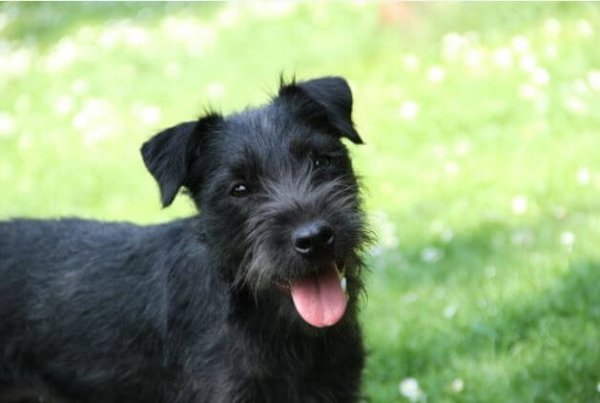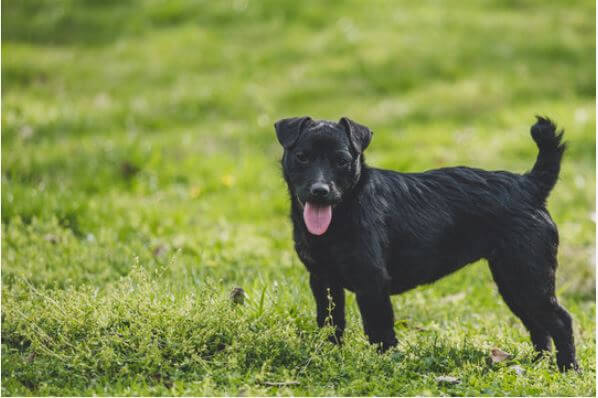The Patterdale terrier is a small-sized, purebred terrier of British origin.
These dogs are very energetic, which is fun for the family, but they’ll wreak havoc in the house if left alone for long periods of time. They prefer humans over other dogs or animals for companionship, so they make great family pets.
Patterdale terriers typically cost $400 to $800 USD.
TABLE OF CONTENTS
What is a Patterdale Terrier?

From Adobe Stock
The Patterdale Terrier is the product of centuries of Terrier breeding, and originate in the Lake District of England. These agile, energetic dogs were bred to hunt and kill vermin that posed a threat to farm crops and livestock. Today, Patterdale Terriers are most commonly kept as pets, but their strong hunting instinct still dominates their personalities.
By cross-breeding the extinct Northumberland Pit Terrier the Old English Terrier, a man named Joe Bowman worked in the early 1900s to create a high-quality hunting terrier. In the 1930s, a hunter and schoolteacher named Cyril Breay continued to refine this Fell Terrier breed until it could successfully hunt small mammals such as foxes, rats, rabbits, and badgers.
In the 1950s controlled breeding continued to perfect this dog, and by 1960 the Patterdale Terrier as we know it today reached its final size and form. A British breeder named Brian Nuttall worked with the Breay and Buck bloodlines to produce the Nuttall bloodline. The Nuttall Patterdale puppies are the most highly regarded in Great Britain and are the most expensive.
In northwest English, the ground is dry and rocky. The climate and terrain are not suitable for raising crops, so it was traditionally an area populated by sheep farmers. Dogs that could dig were not necessary for such a rocky area where the foxes threatening the herds mostly lived in stone dens or crevices.
Thus the Fell Terriers – the Patterdale Terrier included – were particularly suited to drive the foxes out into the open where hunters or the dogs themselves could kill them. These little dogs were able to compress their lungs so they could flatten themselves on the ground with their front and back legs extended, or squeeze into narrow burrows and crevices to flush out their prey.
According to the United Kingdom Kennel Club standards, the Patterdale Terrier is not recognized as an official breed of its own, but rather a type of Fell Terrier breed. Interestingly enough, both the United Kennel Club and the American Dog Breeders Association classify standards for the Patterdale Terrier as an official breed, even though this dog is not as common in the United States as it is in the United Kingdom.
The Patterdale Terrier was first brought to the United States in 1978 to help farmers keep raccoons, groundhogs, and foxes at bay. This is an energetic, adaptable, hardworking dog. It is intelligent enough to find specific prey and has enough endurance and determination to keep up the chase until it kills or completely banishes the object of the hunt.
Appearance
Weight and Size
Patterdale Terriers grow to 10 to 15 inches (25 to 38 centimeters) tall and weigh about 11 to 13 pounds (5 or 6 kilos). Its weight is always in proportion to its height, and its body is wiry and fit looking.
With a body that is only slightly longer than it is tall, the Patterdale Terrier is shaped like a box. Its head is wedge-shaped, and its muzzle is strong and firm. The eyes should not protrude and are set wide apart in the skull. Patterdales have triangular-shaped ears with the tips folding tightly forward, pointing towards the eyes. This dog has a muscular neck that increases in width from the base of the skull, blending seamlessly between the shoulders.
A Patterdale Terriers’ legs are straight, strong, and muscular. The tail is held high but does not curve over the back.
Patterdale Terriers usually live for 10 to 12 years, though some can live to be as old as 15 years old.
Common Colors
Traditionally, Patterdale Terriers are one solid color, with no white markings at all. The most common color is black, but this dog can also be brown or red, with all the possible shades in between. On rare occasions, they can be brindle but are never totally white.
Coat
A Patterdale Terriers will have one of three types of coats: smooth, broken, or rough.
Smooth coat:
- the hair is short, dense, and coarse, falling immediately back into place if lifted
- little grooming is needed
- no waves or curls in the hair
Broken coat:
- the hair is slightly longer than that of the smooth coat, with the hair on the outer coat being slightly longer than the undercoat.
- The hairs on the outer coat are wiry, coarse, and can be wavy
- little grooming is necessary
- the dog may have even longer hair forming bushy eyebrows, a beard, and a mustache
Rough coat:
- very long hairs all over the body and head, including prominent hair on the face, muzzle, and chin.
All three types have a short, dense undercoat that protects the dogs from harsh weather.
Personality and Temperament

From Adobe Stock
Patterdale Terriers will keep you on your toes, but also provide you with endless entertainment. Their personalities include many opposing traits. For example, they are very brave and have an excess of self-confidence, but on the other hand, they are not very friendly towards other dogs. They are extremely energetic, which makes them fun to play with, but they can also get so wound up they destroy household objects and bark loudly non-stop.
In terms of loyalty to their owners, Patterdale Terriers are loving and will want to spend time at your side whenever possible. While they love to run and hunt for toys or actual live animals, they won’t be happy sleeping outside in the yard. Your bed will be their first choice for where to spend nights.
Due to their curious and intelligent natures, if you don’t provide something for your Patterdale Terrier to do he will devise an activity of his own. If left alone too long inside, you might come home to ripped rugs and furniture damaged by your dog’s insistent digging and chewing to find some imaginary prey.
Behavior around other dogs
Patterdale Terriers were not bred to live in packs, but they can learn to tolerate and even enjoy the presence of other dogs if they are socialized often at an early age. Your Patterdale Terrier may be so determined to please you that he will forget how small he is and try to dominate much larger dogs. It will take time to teach him to trust another dog and coexist alongside it without feeling the need to always pick a fight.
It is a good idea to find several friends with dogs to meet on a regular basis. That way your Patterdale with have familiar dogs to play with, and on walks or in the park you will have your own friends to hang out with who understand your dog’s idiosyncrasies.
Even if you think your Patterdale Terrier is calm and well trained, don’t leave him alone with puppies, kittens, rabbits, or small birds. His hunting instinct can kick in at any moment, and he will thoroughly enjoy the opportunity to chase, capture, and even kill what he perceives as a fair game.
Is a Patterdale Terrier a Good Family Dog?
Since Patterdales prefer human beings to other animals for company, they make wonderful family pets. In general, they do well with children, but can sometimes be problematic around toddlers and infants. A Patterdale Terrier may associate a baby’s cry with the sound an injured animal makes, and decide to play a “hunting” game with the unsuspecting “prey.”
Patterdale Terriers are very cute and relatively small, but they are definitely not lap dogs. This is not the choice for sedentary owners that spend hours in chairs reading books or watching TV. Patterdales need lots of activity and exercise and are best suited for families with at least two members that can play with them at home and take them on long walks and runs.
How to Train a Patterdale Terrier

From Adobe Stock
If you want a dog that is going to entertain itself and wait around for you to find time to give it attention, don’t get a Patterdale Terrier. This is a dog that wants to be led, wants to hear and follow commands, wants a “master” in every sense of the word. He wants to please you and be praised for his actions and is intelligent enough to excel at any sort of dog training you give him.
Patterdales love routine, and will soon learn when you are expected home from work and will wait for you on the front step or just inside the door. They should not be let off-leash when taking long walks in residential areas, because the sight of a cat can send them off on a chase. To get your Patterdale to come back, get him accustomed to one specific whistle or high-pitched tone of voice when you call him.
How to Care for a Patterdale Terrier
Exercise Requirements
Patterdale Terriers were bred to be robust and energetic, with seemingly endless stamina. As often as you have time for walks, your Patterdale Terrier will be excited to go. Two long walks a day are mandatory, and if possible you should take different routes. Visit places like dog parks or large fields and forests where you can let him off leash to run around and explore.
A Patterdale won’t be happy living in an apartment. The best setup for this kind of dog is a home with a yard where he can spend time most of the day. Make sure the yard has a sturdy fence with well-grounded posts. A bored Patterdale Terrier is liable to dig his way under a fence in an effort to get out and run.
Grooming and Shedding
While Patterdales shed very little, they should still be brushed once or twice a week to keep their coats healthy. You should also brush a Patterdale Terrier’s teeth at least twice a week, and clean his ears weekly. Make sure no ticks have lodged themselves inside your dog’s ears. His frequent burrowing in bushes and brush make him more susceptible to ticks and other parasites than large dogs that stick to clear paths when taking walks. Twice a year take your Patterdale Terrier to a professional groomer to have dead hairs stripped by hand.
Some owners choose to dock the tail, but no more than one-quarter or one-third of the tail should be removed. That is because this dog often uses its tail to help it wiggle backward out of a burrow. According to English law, docking must be done before the puppy is five days old, and only by a licensed vet.
What to Feed a Patterdale Terrier
Patterdale Terriers need to maintain a healthy diet to live long, healthy lives. The best dog food for this breed is the kibble for small to medium active dogs. You can add water or broth to his food, or mix it with canned food to make it more appetizing.
For treats, you can offer your Patterdale raw fruits and vegetables, cottage cheese, and cooked eggs. However, kibble should still make up 90% of your dog’s diet.
Known Health Problems
Health issues common to Patterdale Terriers include certain eye and spine problems, hypothyroidism, and hip dysplasia. The good news is that all of these conditions and diseases are treatable if diagnosed in time.
A genetic predisposition for health problems means your Patterdale can experience skin allergy that worsens over time. Patterdale Terriers are more likely than other breeds to develop several types of heart disease, and bladder or kidney stones.
Eye problems that Patterdale Terriers are prone to include Glaucoma, primary lens luxation, conjunctivitis, and cataracts.
Orthopedic disorders such as Patellar Luxation and Intervertebral disc disease (IVDD) can also show up in Patterdale Terriers, and treatment may involve surgery.
Some Patterdales also develop dental disease, which affects 80% of all dog breeds by age two. When left untreated, dental disease can damage your dog’s joints, heart, liver, or kidneys. A sick Patterdale may live three years less than a healthy one.
As mentioned in the section about diet, don’t be tempted to feed your Patterdale too many treats or table scraps. That can lead to Obesity, which will only lead to additional health problems.
Patterdale Terriers and Flyball
While hunting with Patterdale Terriers is now outlawed in England, these dogs are excellent competitors in Flyball competitions around the United Kingdom. From 2009 to 2015 a Patterdale Terrier named Chip won multiple prizes in the Flyball events he competed in.
Flyball is a race in which teams of dogs run and jump over a series of hurdles, finally reaching a lever they press to release a tennis ball. The dogs then take the balls in their mouths and run as fast as they can back to their owners. This game demands skill, speed, and determination – traits that Patterdale Terriers are well graced with.
The rules and standards from the game slightly differ between the North American Flyball Association (NAFA) and the United Kingdom Flyball League (UKFL), the fun the dogs have while running the race is the same everywhere.
While Patterdale Terriers originated in Great Britain, they excel in this game that was introduced in California in the 1960s and 1970s. The first official Flyball tournament was held in the United States in 1983, and since then the game has gained popularity all over the world. The fact that this sport requires participation and cooperation between both the dog and its owner makes it a perfect sport for Patterdale Terriers.
To see the results of Patterdale Terriers that participate in British Flyball competitions, see the British Flyball Association site.
Buyer’s Guide

From Adobe Stock
How to Choose a Patterdale Terrier Puppy
Since Patterdale Terriers are still somewhat rare in the United States, and since they are at risk of developing various health problems as they age, it is very important to buy your puppy from a certified breeder with a good reputation. Find a breeder that can give you a year guarantee on your puppy’s health, and will maintain contact with you for the duration of the dog’s life. Serious breeders want to know how a puppy grows and develops, and what kind of personality it has, to help them plan future litters.
Breeders that have rescue and training programs are usually professional and successful, and can be trusted to give the dogs they breed and sell excellent care.
Even if you order a puppy from a breeder before it is even born, make an appointment to visit and choose your actual dog yourself. A puppy that is curious and energetic is preferable to one that is timid and slow to move. Make sure that it wags its tail when interacting with you, and look to see that its eyes are bright and clear.
Ask the breeder if you can return the puppy (with or without a full or partial refund) if living with a Patterdale Terrier just doesn’t work out. Knowing that the breeder values the dog above his “sale”, and will be willing to take it back and try to rehome it, is a sign that he sincerely cares about this breed and making sure his litters go to the best homes possible.
Patterdale Terriers should remain with their mothers until they are ten to twelve weeks old. If you are unable to visit your puppy on-site, ask the breeder to schedule periodic viewings via Zoom. Alternatively, he can send you short videos of your chosen puppy as it grows.
How Much Do Patterdale Terriers Cost?
If you decide to adopt a Patterdale Terrier from a rescue organization or shelter, it will cost about $300 to cover the cost of shots and sterilization. If you want to purchase a pedigreed Patterdale from a breeder, the price can be anywhere between $400 and $800 dollars.
Quick Breed Summary Table
Patterdale Terriers are unique dogs with specific characteristics that play a dominant role in the way you need to care for and train them. Before buying a Patterdale Terrier, carefully weigh the positive and negative aspects of owning this type of dog.
| Pros | Cons |
| Alert watchdog that will bark when strange people or animals approach | Can bark excessively to the point of being annoying |
| Low maintenance coat that needs infrequent washing and brushing | High maintenance in terms of exercise and mental stimulation requirements |
| Brave, confident, eager to please | Will chase and try to catch anything that runs, including children and domesticated cats |
| Loyal and devoted to his owner | Needs strict training, and needs you to set boundaries to learn he is not head of the family “pack” |
| Energetic and happy to work for you | Can become frenzied in its desire to earn your praise, and get out of control |
| Will cheerfully accompany you everywhere and participate in almost any activity | Can suffer from separation anxiety |
Summary
Patterdale Terriers are powerhouses of curious, fun-loving, activity. The downside to this is that they are enthusiastic and impulsive hunters to the point of carelessness – in the United Kingdom, this breed is often killed when running across busy streets in pursuit of other animals. If you decide to buy a Patterdale Terrier, everyone in your household will have to be stringent about keeping doors and gates to the outside shut and locked for the duration of the dog’s life.
On the other hand, your Patterdale Terrier won’t ever ignore you to lay around grooming himself or bask in the sun flat on his back. The minute you are in his vicinity, your dog will be standing at attention ready to go on any adventure you choose.
Given good quality food and attentive health care, your Patterdale Terrier will be the perfect combination of a hunting partner and playmate, a loyal guard when you are afraid and a comforting companion when you are lonely.
His comical whiskered face will keep you smiling, and his wild antics will keep you on your toes. Patterdale Terriers are so endearing that even the fact that they are often all black will never intimidate people who perceive black dogs as dangerous.









Be the first to comment